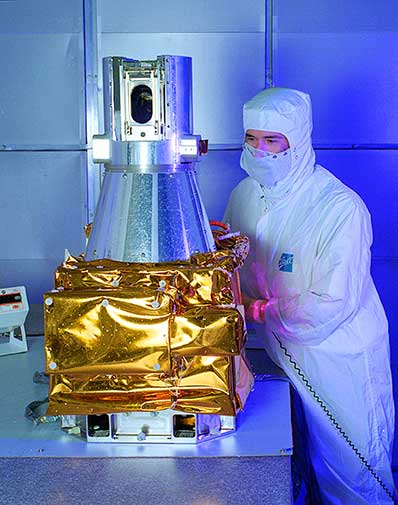
Stratospheric Aerosol & Gas Experiment III
Monitoring pollution
The Stratospheric Aerosol and Gas Experiment III pollution-monitoring instrument will fly to the International Space Station (ISS) in 2017 aboard a SpaceX Falcon 9 cargo resupply launch. SAGE III will be mounted to the ISS where it will operate along with experiments from all over the world.
SAGE III will measure the vertical structure of aerosols, ozone, water vapor and other gases in the atmosphere. The SAGE family of instruments was pivotal in making accurate measurements of the level of ozone loss in Earth’s atmosphere and in measuring the ozone recovery resulting from international mandates. These measurements are vital inputs to the global scientific community to improve understanding of climate, climate change and human-induced ozone trends.
SAGE III will measure the vertical structure of aerosols, ozone, water vapor and other gases in the atmosphere. The SAGE family of instruments was pivotal in making accurate measurements of the level of ozone loss in Earth’s atmosphere and in measuring the ozone recovery resulting from international mandates. These measurements are vital inputs to the global scientific community to improve understanding of climate, climate change and human-induced ozone trends.
NASA SAGE III
Click this link to learn more about the SAGE III instrument on the NASA website.
NASA Earth Observatory SAGE III
Click this link to learn more about the SAGE III instrument on the NASA Earth Observatory website.

What We Did
Instrument provider
We built three SAGE III instruments that were delivered in the late 1990s: the SAGE III Meteor-3M instrument, the SAGE III Flight of Opportunity instrument and the SAGE III on ISS instrument.
SAGE III was originally built to fly on the ISS as early as 2005, but launch was delayed due to design changes on the station’s Earth-facing exterior. The instrument spent several years in storage at NASA’s Langley Research Center, and in 2011, we began refurbishing it.
This activity included assessing whether the stored instrument was suitable for flight. The original optical attenuator mechanism was removed and replaced with a refurbished unit. Several flight software changes were identified and completed to accommodate the updated ISS mission.
We’re on contract to support Langley through instrument test, delivery to the launch site, launch and early orbit operations.
SAGE III was originally built to fly on the ISS as early as 2005, but launch was delayed due to design changes on the station’s Earth-facing exterior. The instrument spent several years in storage at NASA’s Langley Research Center, and in 2011, we began refurbishing it.
This activity included assessing whether the stored instrument was suitable for flight. The original optical attenuator mechanism was removed and replaced with a refurbished unit. Several flight software changes were identified and completed to accommodate the updated ISS mission.
We’re on contract to support Langley through instrument test, delivery to the launch site, launch and early orbit operations.
Earth Science
Read more on why climatologists & weather forecasters rely on our data
GEMS
This air pollution sensor is the result of international collaboration with South Korea
OMPS
Learn how our instrument is tracking the ozone layer with high accuracy.
